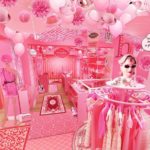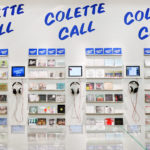What is a pop-up shop? Everything you need to know to try short-term retail > How to set up a pop-up shop in 6 stages. Set yourself up for success with this handy checklist > 16 Amazing Fitting Room Design Tips for Pop-Up Stores
A fitting room is an ideal requirement for pop-up stores. Customers need to try and feel the kind of clothes they’re buying. A nicely done retail fitting room improves customer experience and boosts sales through referrals from satisfied clients.
Boutique dressing room ideas differ from one shop to another depending on the designing a dressing room layout.
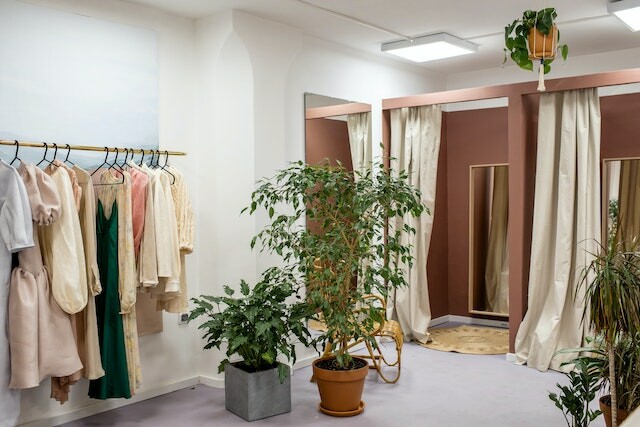
From Smart Shopping Mirrors to AR Fitting Room Software
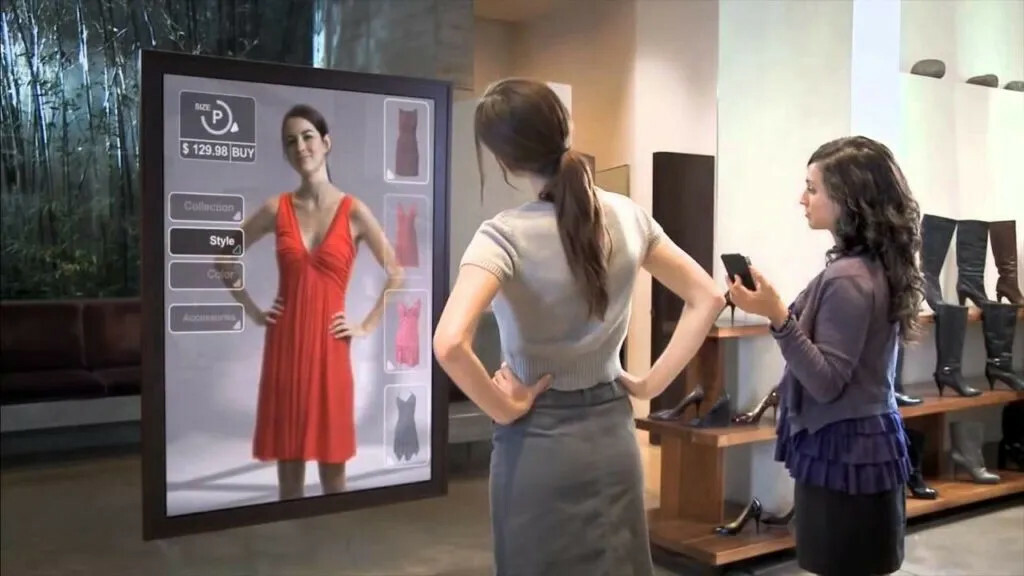
A smart shopping mirror can be installed in any retail space to help shoppers find items more efficiently by displaying product information, such as prices or availability. These mirrors are powered by artificial intelligence fitting room technology and can provide real-time inventory levels and pricing data. They also allow Brick-and-Mortar retailers to display dynamic price changes without manually updating each item’s price tag.
Retailers can use this software to track sales and monitor inventory levels. This helps them better plan future orders, adjust inventories, and reduce unnecessary waste. It can also help them identify trends to improve customer service and increase sales.
The clothing store fitting room technology helps retailers track how customers use their space, allowing them to optimize their layout and design elements. This software is usually used by fashion brands such as Zara and H&M.
Stores are using smart mirrors to help customers find what they want faster. They also use software to track how many people visit each store and where they go.
What Is A Fitting Room?
A fitting room is a designated room in a store or a shop where a customer can try on new clothes before purchasing. A changing room has to be spectacular to stand out among customers. Look no further if you’ve been struggling with designing your retail fitting room. The following nine design tips will make your clothing store fitting room average exceptional.
Fitting Room Tips and Ideas
Boutique fitting room ideas are a very important part of any business. They are where people go to try on clothes and find out if they fit.
To bring out the best and most authentic aspects of retail fitting rooms for retail stores, you need to design them to offer customers comfort, uniqueness, and reliability. You can design a superior store dressing room by doing the following tips.
1. Ensure the space is more than enough
Whether it’s a boutique dressing room, changing room or store dressing room, a customer should be able to try on clothes comfortably without the fear of tripping and falling into the next changing room. Ideally, the fitting fashion room should be big enough to fit four people at once.
Most people shop in pairs or as a family. For friends who shop together, their joy is to try clothes on together, and the roomy fitting room comes in handy.
In addition to a bigger space, ensure the clothing store fitting room is ADA (Americans with Disabilities Act) compliant by following the guidelines. By incorporating ADA requirements, your fitting rooms will be welcoming and can serve anyone.
2. Incorporate seating into a dressing room
Additional storage options, such as a bench or a chair in the clothing store fitting room, are a good gesture that goes a long way. When a customer tags along a shopping buddy, the friend can rest as your customer tries on the new clothes. Alternatively, the chair can place customers’ shopping and other items.
Remember the clients who shop as a family; you’ll need to provide a bigger bench for relaxation as the other members shop and try different clothes. If it doesn’t break the bank, you can include a TV and a play area for children.
Such dressing room ideas for boutiques leave a permanent mark on shoppers; thus, they become returning clients and refer other customers. It’s a win-win situation for you.
3. Use neutral lighting
Designing a retail dressing room can never be complete without lighting. Customers want to appear and look like models when trying on new clothes. With perfect natural light, your clients will have heaven on earth. Your biggest desire is to see your client’s face glittering with joy while carrying bags full of shopping from your store.
Overly stark shadows caused by narrow-beam spotlights can be a source of frustration when trying on new clothes. Atmospheric lighting will make clients feel better when looking in the mirror. Light naturally comes from above by observing nature; a vertical and horizontal combination of lighting will give the perfect radiation for your customers.
4. Create privacy
The privacy should be paramount in fitting rooms. Although curtains are more popular, you can take an extra step by including changing room doors to assure your customers of their privacy. Doors represent VIP or luxury treatment for your clients but are the costliest option. On the other hand, some customers don’t feel safe changing behind the curtains.
The half-door will do the trick to close the gap between losing clients and breaking the bank. It’s safer and more comfortable than curtains, and most clients will be free to try their new clothes without worrying about who is peeping at them.
5. Minimize decoration fixtures
Your fitting rooms should be welcoming, calm and relaxing. Any kind of decoration that is distracting should be avoided. On the walls, avoid graffiti and portrayals of celebrities or freedom fighters. Customers shouldn’t be entering fitting rooms with user manuals on locating the mirrors.
Simplicity is king. Your clients should be in and out of the boutique dressing rooms without being distracted by stylish portraits and walls. Keep the changing room with a seamless design and remove any striking designs.
The light colors of your fitting rooms can influence how much money you make from selling clothes. If you sell women’s clothing, pink is the best girly color for your clothing store fitting room. Pink attracts female customers who want to look nice. However, blue is the best color for the fitting room if you sell men’s clothing. Blue attracts male customers who like to shop.
Adding neutral colors helps make the space feel less intimidating and allows people to focus on what they’re wearing instead of how they look. Furthermore, choosing a neutral color for your fitting room walls will help customers concentrate on the clothes they’re trying on instead of being drawn into the bright colors and patterns of the wall.
Read More: How colors can drive sales at your Pop-Up Store?
6. Clean your fitting rooms
Customers can smell dirty fitting rooms from miles away. Your goal is to make clients feel at home, and once they’re comfortable, they can try clothes on and make purchases. The nice decor and stunning final touches will not count if your changing room isn’t tidy.
One way of ensuring customers experience the best hygiene is to schedule cleaning sessions. An in-between cleanup is ideal when a client is done trying clothes. It doesn’t have to be a complete cleanup, but whipping the mirrors or clearing the trash.
The full cleanup of the fitting rooms should be done at the end of the day or the following morning. The cleaning should be thorough to ensure the customer experience is top-notch.
7. Install mirrors
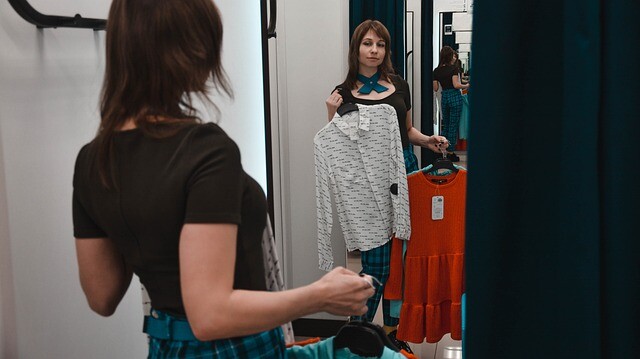
Fitting room mirrors add life to store changing rooms. The reason why customers try new clothes is to take a glimpse of what they would look like in them. For instance, shoppers would opt to purchase clothes in physical stores compared to online stores because they can always check the new clothes in the mirror and decide whether to buy them.
The kind of mirror in your fitting room will determine if a customer will make a purchase. Quality mirrors give accurate reflections and tend to inspire and paint a hero’s portrait in shoppers’ minds. Avoid mirrors used in barbershops as they concentrate on the facial part alone.
Ensure your changing room is equipped with mirrors that display full-body reflections because they always leave customers perplexed. Clients will always flock back to your store if you can raise their self-esteem. You don’t require any scientific inventions; invest in quality mirrors that present true reflections.
8. Staff your fitting rooms
The best way to staff your fitting rooms is to hire someone who is experienced at it. They will know what works well and what doesn’t. Finding someone who knows how to manage all aspects of the fitting space, including lighting, temperature control, and ventilation, is essential.
You need to consider your available shopping space for people if you want to staff your fitting rooms for pop-up stores. The first thing you should do is determine what additional sizes of stores you would like to open. Next, you must decide whether you want to hire one or multiple people. Finally, you need to consider where you’ll set up the shop.
9. Lower your music
The music playing in a fitting room should be soft enough not to disturb customers trying on clothes but loud enough to keep them engaged.
You will find some tips below if you want to lower the music volume during fitting rooms.
- Use white noise machines. White noise machines are used to mask unwanted sounds like traffic outside. It helps people relax and focus on their shopping. They are available at any local departmental stores.
- Use dim lighting. Dim lighting makes it easier for shoppers to see what they are wearing. The best lighting should be soft and not too bright.
- It’s important to choose music that will encourage people to browse around and spend money.
10. Creating a luxurious fitting room experience
When it comes to creating a luxurious fitting room experience, there are a few things you can do to really wow your customers. First, pay attention to the details and make sure everything is spotless. This includes the floor, walls, mirrors, and any other surfaces.
Second, provide comfortable seating and make sure there is plenty of space for customers to move around. Third, offer a variety of services such as refreshments, complimentary alterations, and so on. By taking care of these details, you’ll be sure to create a fitting room experience that is truly luxurious.
11. Incorporating technology into the fitting room
Incorporating technology into the fitting room experience can enhance the customer journey and create a more seamless in-store experience. By using digital tools, retailers can provide a more personalized and efficient fitting room experience, leading to increased sales and customer satisfaction. There are a few ways that technology can be integrated into the fitting room to create a more enjoyable experience for shoppers.
For example, retailers can use digital displays to show product information and recommendations, which can help shoppers make more informed decisions about their purchases. Additionally, retailers can use RFID tags to keep track of inventory and ensure that the right sizes and styles are available in the fitting room. And finally, retailers can use technologies like virtual reality to give shoppers a realistic view.
12. Creating a Positive Customer Experience
Creating a positive customer experience in the fitting room is critical to retail success. There are a few key things you can do to ensure your customers have a positive experience in the fitting room:
- Make sure the fitting room is clean and organized. This will give your customers a good first impression and make them feel more comfortable trying on clothing.
- Be sure to offer a variety of sizes in each style of clothing. This will allow your customers to find the perfect fit and be more likely to purchase.
- Be attentive to your customers’ needs. If they need help finding a certain size or style of clothing, be sure to offer assistance.
13. Make sure your fitting room is well-ventilated
It is important to ensure that your fitting room is well-ventilated to avoid any discomfort for your customers. Additionally, a well-ventilated room will help to prevent any build-up of moisture or odors. Not only will this help you avoid unpleasant smells, but it will also help you stay cool and comfortable.
14. Display your merchandise in an appealing way
When displaying merchandise in a fitting room, it is important to make sure that the items are arranged in an appealing way. This will help create a positive shopping experience for customers and may encourage them to purchase.
Some tips for arranging merchandise in a fitting room include:
- Grouping items by type or color
- Creating symmetrical or balanced displays
- Using attractive packaging or signage
- Making sure that the merchandise is clean and in good condition
15. Incorporate different textures and materials
When shopping for clothes, the fitting room is an essential stop. Not only does it give you a chance to try on the garment to see if it fits, but it also allows you to get a feel for the fabric and the overall look and feel of the piece. This is why creating an inviting and comfortable fitting room space that incorporates different textures and materials is important.
This will not only make the experience more enjoyable for shoppers, but it will also help them to make better decisions about the clothing they purchase. Some simple ways to add different textures and materials to a fitting room include adding a plush rug or throw blanket, hanging tapestries or curtains, and using different lighting fixtures.
16. Use a conveyor belt to bring clothes to the fitting room
A conveyor belt can be a great way to bring clothes to the fitting room in a retail setting. This can help to reduce congestion and ensure that customers can try on items in a timely manner. However, there are a few things to keep in mind when using a conveyor belt in this way.
First, be sure that the conveyor belt is wide enough to accommodate the clothing items you plan to bring to the fitting room. Second, make sure that the conveyor belt is long enough to reach the fitting room without causing any disruption to other areas of the store. Finally, monitor the conveyor belt regularly to ensure that it is functioning properly and that clothes are not getting stuck or lost.
Conclusion
A fitting room can be your gateway to great sales and customer satisfaction. An exceptional changing room will accommodate customers from all walks of society, and a good gesture to the community will always be repaid in the future.
- How to Open a Successful Pop-Up Shop in London’s Fast-Fashion Neighborhoods - December 23, 2022
- The Benefits of Opening a Pop-Up Shop in NYC’s Fast-Fashion Neighborhoods - December 23, 2022
- Reaping the Benefits of Long-Term Pop Up Stores: Tips and Advice - December 23, 2022

